OTHER COMETS
144P Kushida


2009 Jan 24..5UT.
Left:
Kushida and the Hyades star cluster (Aldebaran at far right)
3 minute exposure, Canon 300D. 200mm zoom
lens, cropped image. ISO 800.
Right: 3x3 minutes combined exposure.
Visual magnitude 8.6
C/2008 A1 McNaught
The comet was closest to the Sun on Sep 29, 2008 at 1.07AU
and achieved a peak brightness of magnitude 6.5 during September 08
for observers in the southern hemisphere. It is now fading and no longer
visible from the Southern hemisphere.

2008 Sep 26.45UT.
A stack of 3x3 minute exposures, Canon 300D digital camera.
300mm zoom lens, cropped image. ISO 800. Visual magnitude 7.0
6P d'Arrest

2008 Nov 1.45UT.
A stack of 3x3 minute exposures, Canon 300D digital camera.
300mm zoom lens, cropped image. ISO 800. Visual magnitude 9.5

177p Barnard
July 21.5 UT 2006.
6 minutes exposure. Canon 300D digital camera + 300mm telephoto
lens. (cropped). ISO 1600. Field of View approximately 3 degrees wide.
Visually magnitude 9.0 with 15' coma.
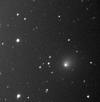

Left:
9P Tempel 1 on June 27th 2005, prior to deep impact.
20x15 second exposures, Starlight Express MX7c imager + C11 at f/3.3.
Right:
9P Tempel 1 on July 4th at 10:15 UT, over 4 hrs post impact.
10x15 second exposures, Starlight Express MX7c imager + C11 at f/3.3.
galaxy PGC 48179 is at top. My observations indicate the nucleus brightened
from mag 14.0
on June 27.45UT to mag 13.3 on July 4.40UT using USNO magnitudes for
comparison.
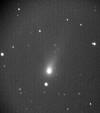
C/2005 A1 LINEAR on May 12.83 UT 2005.
10x15 second exposures, Starlight Express MX7c imager + C11 at f/3.3.
Field of view: 15' wide x 17' long. South is up and West is left.


C/2003 T4 LINEAR on May 12.82 UT 2005
20x15 second exposures, Starlight Express MX7c imager + C11 at f/3.3.
Note the spine in the antisolar direction which may be an
Ion-tail disassociation event.
The Larsen-Sekania filter at right shows the spine in greater detail.
Field of view: 15' wide. South is up and West is left.

C/2003 T4 LINEAR and Helix Nebula on April 8.79 UT 2005
Ion tail is close to 2 degrees long. Note the disturbance along the tail.
6x2min exposures, Canon 300D at ISO 1600 + 90mm lens.
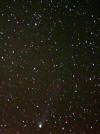
C/2003 T4 LINEAR on April 12.81 UT 2005
5x2min exposures, Canon 300D at ISO 1600 + 205mm lens.
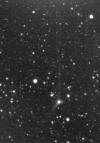
C/2003 K4 LINEAR on Nov 16th 2004.
Taken through a 135mm Hannimex lens at f/5.6 with a 2x1.5 degree FOV.
Note the anti-tail at 7 o'clock and the main ion-tail at 12 o'clock.

78P Gehrels on Oct 9th 2004.
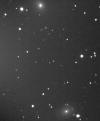
C/2004 Q1 Tucker and galaxy NGC 691 on Oct 9th 2004.

C/2004 R2 ASAS on Sep 18th 2004.

C/2004 H6
SWAN CCD image on 2004 May 21.85UT.
10x10 second exposures through Celestron C11 at f/3.3.
Field of view about 15' wide. Twilight interference.

C/2003 T3 Tabur
CCD image taken on October 22nd 2003. 7x20 sec exposures.
The comet is at top right along with galaxies NGC 6850 (bottom right) and IC
4933 (centre left)
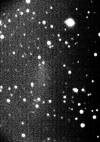
C/2002 O7 LINEAR
CCD image taken on Sep 27th 2003 at 18:59 UT.
C11 telescope operating at f/3.3, 10x20 second exposures.
The image is equalised to draw out faint detail and indicates that the nucleus
has totally disrupted.
What remains is a diffuse, sunward pointing "antitail" of debris.

C/2002 Y1 Juels-Horvocem
rendezvous with galaxy NGC 1543 taken on July 29th 2003.
6x20 second
exposures.
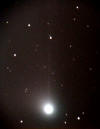
C/2002 Y1 Juels-Horvocem
CCD image taken on May 29th 2003.
C11 telescope operating at f/3.3, 8x20 sec combined exposures.
Visual magnitude 8.0, Coma diameter 4'.

66p du Toit
rendezvous with galaxy NGC 5253 taken on August
15th 2003.
10x20 second exposures.
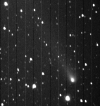
116P Wild 4
CCD image taken on May 3rd 2003. 8x20 second
exposures.

C/2002 X5 Kudo-Fujikawa
CCD image taken on March 5th 2003. 5x30 sec combined
exposures.
Processed to highlight forks in the ion tail.

2002 O6 SWAN
CCD image taken on Aug 7th 2002.
























